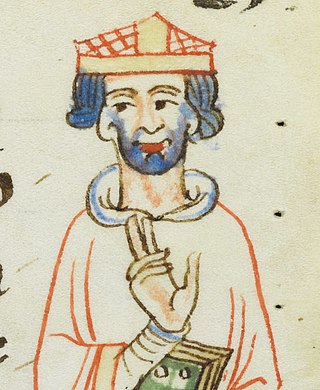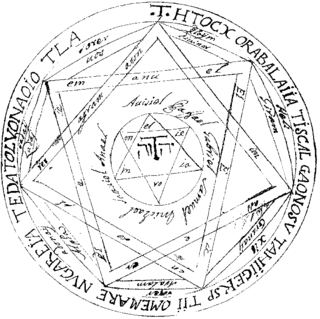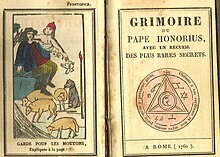
A grimoire is a textbook of magic, typically including instructions on how to create magical objects like talismans and amulets, how to perform magical spells, charms, and divination, and how to summon or invoke supernatural entities such as angels, spirits, deities, and demons. In many cases, the books themselves are believed to be imbued with magical powers, although in many cultures, other sacred texts that are not grimoires have been believed to have supernatural properties intrinsically. The only contents found in a grimoire would be information on spells, rituals, the preparation of magical tools, and lists of ingredients and their magical correspondences. In this manner, while all books on magic could be thought of as grimoires, not all magical books should be thought of as grimoires.

Pope Honorius III, born Cencio Savelli, was head of the Catholic Church and ruler of the Papal States from 18 July 1216 to his death. A canon at the Basilica di Santa Maria Maggiore, he came to hold a number of important administrative positions, including that of Camerlengo. In 1197, he became tutor to the young Frederick II. As pope, he worked to promote the Fifth Crusade, which had been planned under his predecessor, Innocent III. Honorius repeatedly exhorted King Andrew II of Hungary and Emperor Frederick II to fulfill their vows to participate. He also gave approval to the recently formed Dominican and Franciscan religious orders.

The Grand Grimoire is a black magic grimoire. Different editions date the book to 1521, 1522 or 1421, but it was probably written during the early 19th century. Owen Davies suggests 1702 is when the first edition may have been created and a Bibliothèque bleue version of the text may have been published in 1750. The "introductory chapter" was authored by someone named Antonio Venitiana del Rabina who supposedly gathered his information from original writings of King Solomon. Much of material of this grimoire derives from the Key of Solomon and the Lesser Key of Solomon, pseudepigraphical grimoires attributed to King Solomon. Also known as Le Dragon Rouge or The Red Dragon, this book contains instructions purported to summon Lucifer or Lucifuge Rofocale, for the purpose of forming a Deal with the Devil. The 19th century French occultist Éliphas Lévi claimed the contemporary edition of Le Dragon Rouge to be a counterfeit of a true, older Grand Grimoire.

Bael is a demon described in demonological grimoires such as The Lesser Key of Solomon and the Pseudomonarchia Daemonum and also in the Dictionnaire Infernal. He is described as a hoarsely-voiced king with the power to make men invisible and ruling over sixty-six legions of demons. The Lesser Key of Solomon describes him as appearing in the form of a cat, toad, man, some combination thereof, or other "diverse shapes", while the Pseudomonarchia Daemonum and the Dictionnaire Infernal state that he appears with the heads of a cat, toad, and human simultaneously.
The Lesser Key of Solomon, also known as Lemegeton Clavicula Salomonis or simply Lemegeton, is an anonymously authored grimoire on sorcery. It was compiled in the mid-17th century, mostly from materials several centuries older. It is divided into five books: the Ars Goetia, Ars Theurgia-Goetia, Ars Paulina, Ars Almadel, and Ars Notoria. It is based on the Testament of Solomon and the ring mentioned within it that he used to seal demons.

Agares is a demon described in demonological grimoires.
Bathin is a demon described in demonological grimoires.

Paimon is a spirit named in early grimoires. These include The Lesser Key of Solomon, Johann Weyer's Pseudomonarchia Daemonum, Collin de Plancy's Dictionnaire Infernal, the Livre des Esperitz, the Liber Officiorum Spirituum, The Book of Abramelin, and certain French editions of The Grimoire of Pope Honorius ; as well as British Library, Sloane MS 3824.

The Key of Solomon is a pseudepigraphical grimoire attributed to King Solomon. It probably dates back to the 14th or 15th century Italian Renaissance. It presents a typical example of Renaissance magic.

There have been various attempts at the classification of demons within the contexts of classical mythology, demonology, occultism, and Renaissance magic. These classifications may be for purposes of traditional medicine, exorcisms, ceremonial magic, witch-hunts, lessons in morality, folklore, religious ritual, or combinations thereof. Classifications might be according to astrological connections, elemental forms, noble titles, or parallels to the angelic hierarchy; or by association with particular sins, diseases, and other calamities; or by what angel or saint opposes them.

A wand is a thin, light-weight rod that is held with one hand, and is traditionally made of wood, but may also be made of other materials, such as metal or plastic. Long versions of wands are often styled in forms of staves or sceptres, which could have large ornamentation on the top.
The Sworn Book of Honorius is a medieval grimoire purportedly written by Honorius of Thebes. The Latin word "juratus", which is typically translated to "sworn", is intended to mean "oathbound". The book is one of the oldest existing medieval grimoires, as well as one of the most influential.

The Black Pullet also known in French as “la poule aux œufs d’or” is a grimoire that proposes to teach the "science of magical talismans and rings", including the art of necromancy and Kabbalah. It is believed to have been written in the 18th century by an anonymous French officer who served in Napoleon's army. The text takes the form of a narrative centering on the French officer during the Egyptian expedition led by Napoleon when his unit is suddenly attacked by Arab soldiers (Bedouins). The French officer manages to escape the attack, but is the only survivor. An old Turkish man appears suddenly from the pyramids and takes the French officer into a secret apartment within one of the pyramids. He nurses him back to health whilst sharing with him the magical teachings from ancient manuscripts that escaped the "burning of Ptolemy's library".
Turiel is a fallen Watcher in the ancient apocryphal text known as the Book of Enoch. In later translations, he is one of the 20 leaders of 200 fallen angels, mentioned eighteenth. The name is believed to originate from tuwr "rock" and El "God", meaning "rock of God", while the translation taken from M. A. Knibb's work on the Ethiopic Book of Enoch is either "Mountain of God" or "Rock of God".

The Arbatel De Magia Veterum is a Latin grimoire of Renaissance ceremonial magic published in 1575 in Switzerland.
The Grimoire of Pope Leo or Enchiridion of Pope Leo is a French grimoire that is pseudepigraphically attributed to Pope Leo III. The book claims to have been published in 1523, but the earliest known version of the text is from 1633. It was listed in police records in association with the Affair of the Poisons, and a copy was owned by Marc Antoine René de Voyer.
The Grimorium Verum is an 18th-century grimoire attributed to one "Alibeck the Egyptian" of Memphis, who purportedly wrote in 1517. Like many grimoires, it claims a tradition originating with King Solomon.

Petit Albert is an 18th-century grimoire of natural and cabalistic magic. The Petit Albert is possibly inspired by the writings of Albertus Parvus Lucius. Brought down to the smallest hamlets in the saddlebags of peddlers, it represents publishing success, despite its association with "devil worshipers"—or rather because of it. It is associated with a second work, the Grand Albert. It is a composite, heterogeneous work, collecting texts of value written by various authors; most of these authors are anonymous but some are notable such as Cardano and Paracelsus. Due to its historical nature, Albertus Magnus' attribution to the text is considerably uncertain and since the text quotes from many later sources, it is an ethnological document of the first order.
The Codex coemeterium is a 16th-century grimoire manuscript. The text, composed in Latin, is largely concerned with demonology and necromancy. The book falls into A.E. Waite's category of 'Unprinted literature of ceremonial magic' though extracted elements have been reproduced in later treatises. It is heavily based on the Key of Solomon, which was listed in the Catholic Church's index of prohibited books.

The Grand Albert is a grimoire that has often been attributed to Albertus Magnus. Begun perhaps around 1245, it received its definitive form in Latin around 1493, a French translation in 1500, and its most expansive and well-known French edition in 1703. Its original Latin title, Liber Secretorum Alberti Magni virtutibus herbarum, lapidum and animalium quorumdam, translates to English as "the book of secrets of Albert the Great on the virtues of herbs, stones and certain animals". It is also known under the names of The Secrets of Albert, Secreta Alberti, and Experimenta Alberti.












